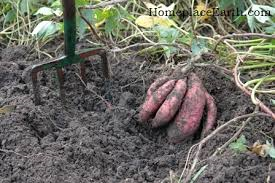
Sweet potatoes aren't started from seed like most other vegetables. Rather, they are started from slips, which are shoots from a mature sweet potato. When I wasn't able to find sweet potato slips at local nurseries, I did what I usually do when I have a need. I Googled “sweet potato slips” and found quite a few online sources.
Most of them did not ship to California. On the California Department of Food and Agriculture's website, I learned that certain states are prohibited from shipping sweet potatoes to California because of the presence of the sweet potato weevil in those states. If I wanted sweet potato slips, I would have to find a source that was not in Alabama, Arkansas, Florida, Georgia, Hawaii, Louisiana, Mississippi, South Carolina, Tennessee or Texas. Fortunately there is a source in Virginia.
Sweet potatoes slips are shipped from Mid-May to early June. Once received, they should be planted within a few days.
Before your slips arrive, you have a little work to do. Sweet potatoes need loose, well-drained soil to form large tubers. Loose soil is more critical than almost any other factor. You don't want the roots to face resistance when they try to expand.
If you have clay soil or drainage problems, work in lots of compost. I have both, so I grow all of my vegetables in raised beds to which I have added four to five inches of compost. Sweet potatoes grow best in moderate to slightly acidic soil so pH should be in the 5.5 to 6.5 range. If your soil pH is higher than that, add more compost but don't expect the pH to change overnight.
Plant slips 2 to 3 inches deep and 12 to 18 inches apart, with the leaves above ground. Space rows 3 feet apart if possible to accommodate the sprawling vines. Plant in late afternoon so that the slips can settle in before being exposed to direct sun.
Give plants a thorough soaking after planting. Water daily for the first week, then every other day the second week. Each week, space the watering a little farther apart until you're watering once a week. Sweet potatoes can withstand drought but they'll produce less, so make sure you keep the ground moist during the hottest part of the summer. Regular watering will assure a larger harvest, and even moisture will help prevent splitting and cracking.
Like other vegetables, sweet potatoes don't like to compete with weeds for soil nutrients and water. Start with a weed-free environment and then keep it that way. Your sweet potatoes will soon produce foliage that will crowd out weeds, so you only need to be vigilant for a short time.
Historically, sweet potatoes have been regarded as a poor-soil crop, one that produces a decent harvest in imperfect soil. But they do much better with a little fertilizer. About two weeks after planting, feed with a balanced organic fertilizer such as 5-10-10. Use about 2 cups per 30 square feet (the size of a 4x8 raised bed). Gently scratch the fertilizer into the soil. Then cover soil with an inch of your favorite mulch.
Harvest sweet potatoes when they reach your preferred size. Dig one up when your crop reaches the recommended growing time for the variety (generally between 90 and 120 days.) If the tubers are still too small for your liking, try again in a week. Sweet potatoes left in the ground will continue growing until frost, although growth slows as the weather cools. For best storage quality, harvest sweet potatoes before the soil temperature drops below 55°F.
Sweet potatoes require a curing process to heal any scratches or other damage, develop sweetness and improve storage quality. Immediately after harvest, let the sweet potatoes dry fully, then shake off excess soil. Do not wash the sweet potatoes. Cure them by keeping them at 90 percent relative humidity and 85°F for seven to ten days.
For long-term storage after curing, choose firm, round, bruise-free, well-shaped sweet potatoes with fairly even coloring. Store them in a cool (over 55°F), dry, well-ventilated area away from light. Do not refrigerate sweet potatoes unless they are already cooked. Cold temperatures will give sweet potatoes a hard core and affect the flavor. Properly cured sweet potatoes should store for 5 to 12 months unrefrigerated.
Workshop: Napa County Master Gardeners will conduct a workshop on “Habitat Gardens at Home or School” on Saturday, May 16, from 9:30 a.m. to 11:30 a.m., at Skyline Park, Martha Walker Garden, 2201 Imola Avenue, Napa. Participants will tour the Martha Walker Garden to discover the plants and garden elements that attract bees, birds and pollinators. Master Gardeners will explain the value of habitat corridors whether the garden is in a rural, urban, or school setting.Online registration (credit card only)Mail-in registration (cash or check only)
Master Gardeners are volunteers who help the University of California reach the gardening public with home gardening information. Napa County Master Gardeners ( http://ucanr.org/ucmgnapa/) are available to answer gardening questions in person or by phone, Monday, Wednesday and Friday, 9 a.m. to Noon, at the U. C. Cooperative Extension office, 1710 Soscol Avenue, Suite 4, Napa, 707-253-4143, or from outside City of Napa toll-free at 877-279-3065. Or e-mail your garden questions by following the guidelines on our web site. Click on Napa, then on Have Garden Questions? Find us on Facebook under UC Master Gardeners of Napa County.